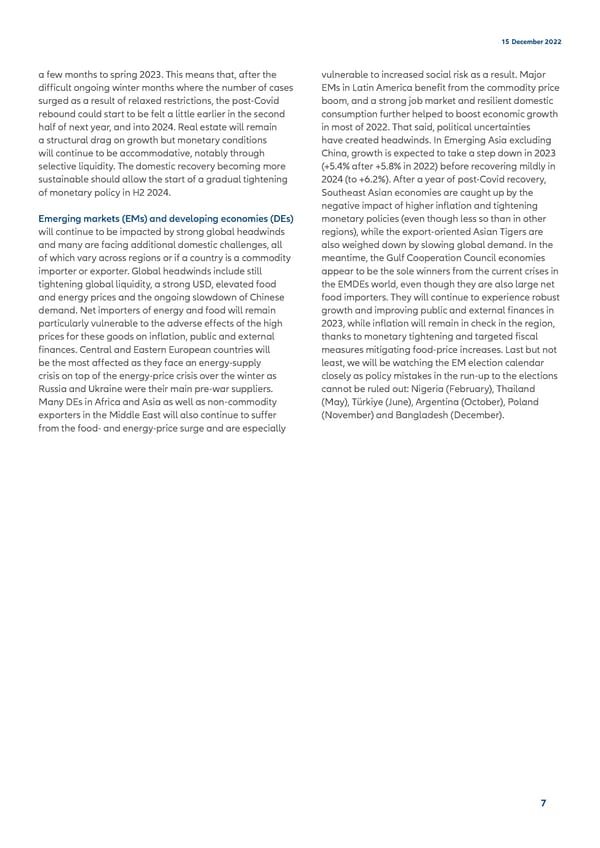15 December 2022 a few months to spring 2023. This means that, after the vulnerable to increased social risk as a result. Major difficult ongoing winter months where the number of cases EMs in Latin America benefit from the commodity price surged as a result of relaxed restrictions, the post-Covid boom, and a strong job market and resilient domestic rebound could start to be felt a little earlier in the second consumption further helped to boost economic growth half of next year, and into 2024. Real estate will remain in most of 2022. That said, political uncertainties a structural drag on growth but monetary conditions have created headwinds. In Emerging Asia excluding will continue to be accommodative, notably through China, growth is expected to take a step down in 2023 selective liquidity. The domestic recovery becoming more (+5.4% after +5.8% in 2022) before recovering mildly in sustainable should allow the start of a gradual tightening 2024 (to +6.2%). After a year of post-Covid recovery, of monetary policy in H2 2024. Southeast Asian economies are caught up by the negative impact of higher inflation and tightening Emerging markets (EMs) and developing economies (DEs) monetary policies (even though less so than in other will continue to be impacted by strong global headwinds regions), while the export-oriented Asian Tigers are and many are facing additional domestic challenges, all also weighed down by slowing global demand. In the of which vary across regions or if a country is a commodity meantime, the Gulf Cooperation Council economies importer or exporter. Global headwinds include still appear to be the sole winners from the current crises in tightening global liquidity, a strong USD, elevated food the EMDEs world, even though they are also large net and energy prices and the ongoing slowdown of Chinese food importers. They will continue to experience robust demand. Net importers of energy and food will remain growth and improving public and external finances in particularly vulnerable to the adverse effects of the high 2023, while inflation will remain in check in the region, prices for these goods on inflation, public and external thanks to monetary tightening and targeted fiscal finances. Central and Eastern European countries will measures mitigating food-price increases. Last but not be the most affected as they face an energy-supply least, we will be watching the EM election calendar crisis on top of the energy-price crisis over the winter as closely as policy mistakes in the run-up to the elections Russia and Ukraine were their main pre-war suppliers. cannot be ruled out: Nigeria (February), Thailand Many DEs in Africa and Asia as well as non-commodity (May), Türkiye (June), Argentina (October), Poland exporters in the Middle East will also continue to suffer (November) and Bangladesh (December). from the food- and energy-price surge and are especially 7
 Allianz 2022 Outlook final Page 6 Page 8
Allianz 2022 Outlook final Page 6 Page 8